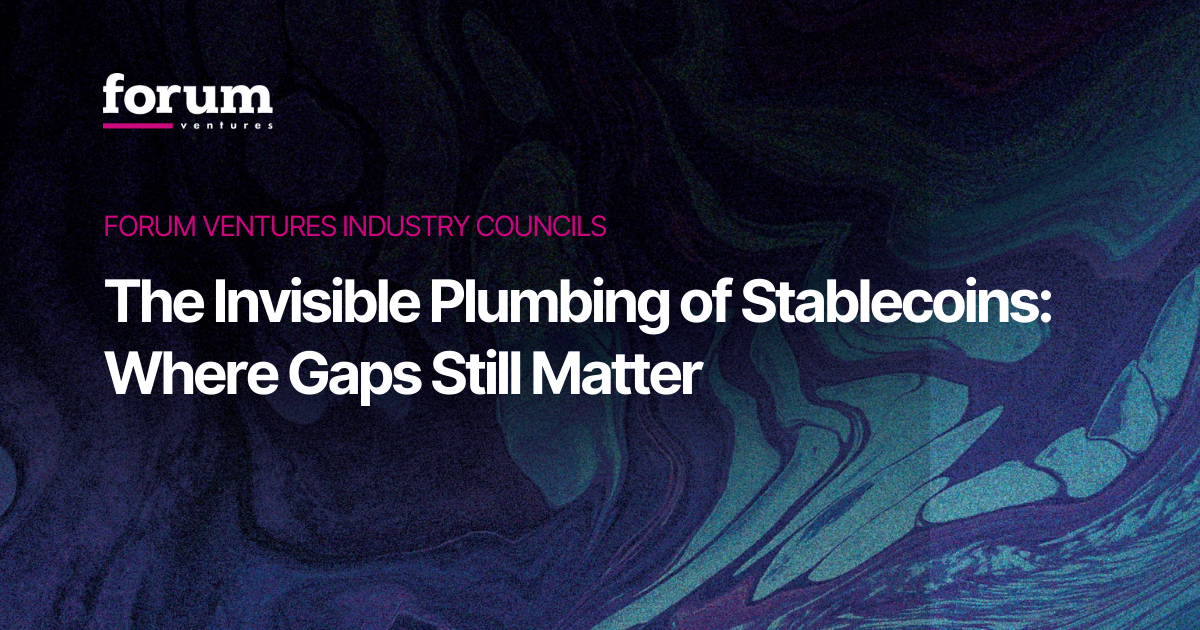The Fortune 500 might seem like a single block of companies, but the reality is each company faces unique challenges, opportunities, and threats. One common thread, though, is that every Fortune 500 innovator has to think about keeping operations going today while planning for tomorrow. This is a fundamental difference between enterprise versus startup innovation. In an enterprise ecosystem, there are decades of process to augment and thousands of employees to consider - you can’t simply throw it out and start again.
During the research process for the Forum Ventures Enterprise Innovation Playbook, where we spoke to hundreds of CIOs, we uncovered the mental models and action frameworks corporate innovation leaders use to keep the wheels turning today while steering the organization toward a more innovative tomorrow. In this article we’ll explore two of those frameworks:
The three innovation tests
When creating an innovation strategy that works for today and tomorrow, corporate innovation leaders run their concepts through three different tests.
1 - The elasticity test: Elasticity refers to the idea that whatever you work on in the short term will feed the long-term (even if it’s just pieces, parts, or small structures that need expansion).
2 - The flexibility test: Flexibility ensures that your definition doesn’t get too narrow. If you focus on threat detection, for instance, that can’t inhibit you from also looking at new opportunities.
3 - The customer test: Not every corporation needs to tackle every kind of innovation. Make sure your conceptual definition tracks directly to customer wants and needs. Dan Regalado, the VP, Global Technology Transformation & Strategic Partner Management, Walgreens Boots Alliance, said it simply: “It’s always a customer first mentality when it comes to innovation.”
These tests offer a chance to analyze each idea for relevance. Because innovation is cumulative, having an ‘elastic’ idea means your ideas now will help in the future. Ensuring flexibility means you can react to market forces and stakeholder needs. And focusing on customers means your ideas will always be geared toward business outcomes.
Building for impact now and tomorrow
Arthur Orduna, the chief innovation officer at Avis Budget Group, explained that the job of an innovation leader is to help increase profitability today and plan for any upcoming threats or opportunities. However, starting an innovation journey requires the right foundation. To set the foundation, he recommended a 30 / 60 / 90 day framework for any innovation project.
30 days: Know the challenges
Get a sense of core challenges faced by all stakeholders, especially those responsible for a P&L statement. Document all these challenges before you start brainstorming solutions - as an innovation leader, you need to start with the issues, challenges, and opportunities in front of you first. If you go immediately to big, long-term plans, you risk losing support in the organization.
60 days: Take action to solve current problems for stakeholders
Focus first on creating a win for stakeholders. Ideally, this is focused on quick wins that you’re capable of solving either through previous experience or based on the nature of the challenge. Concurrently, you should be planning your longer-term strategy. In Arthur’s experience, leveraging startups has been productive. Look for startups that already make a solution (whole or partial) to the problems you face, so you can run implementation quickly and start to see benefit.
90 days: Make an impact for a stakeholder while planning for the next step
This is when you need a win on the board, as Arthur says. You should have made a positive impact for at least one P&L-owner. This is also when you can more thoroughly present any longer-term strategies or focuses you have. While the win may not seem like a big deal to you, it will help garner the support of stakeholders for the bigger, more ambitious projects. And if the work you do fits the elasticity, flexibility, and customer tests, then it will still support your larger goals.
“In year one especially, focus your efforts on producing quick wins to give your CEO air cover and data to defend you against any potential naysayers in the executive ranks or on the board,” said Arthur Orduna. This will give you credibility to launch longer-term, more aggressive projects.”
After year one, you can repeat this kind of planning for each major innovation project - that way you have ongoing priorities starting and going at concurrently
Innovation requires empathy
When innovating in a Fortune 500-sized company, there is already a lot of process and history in place. No matter how much the organization needs innovation, you can’t throw out the whole thing and start again - there’s too much riding on how business operates today. Instead, innovation leaders have to think short and long term concurrently, helping people succeed now and build up for later. It’s why Forum Ventures often describes the role of an innovation leader more like a wilderness guide than a c-suite executive. You have to help bring people along on a journey, providing wins and encouragement along the way.
Want more frameworks and tactics to build your corporate innovation strategy? Download the Forum Ventures Enterprise Innovation Playbook.
--
Interested in connecting with other Innovation and technology executives to share strategies, experiences and learnings? The Innovation Forum brings together Innovation execs across sectors to connect, share and support each other. Get exclusive resources, expert talks and first access to our growing community of B2B startups. Learn more by emailing me at Jon@forumvc.com.
.avif)
.avif)



.svg)




.avif)

